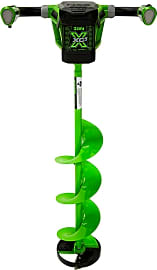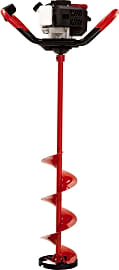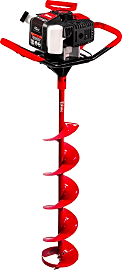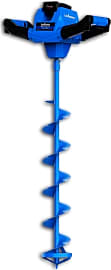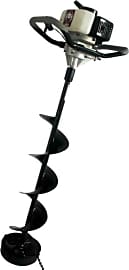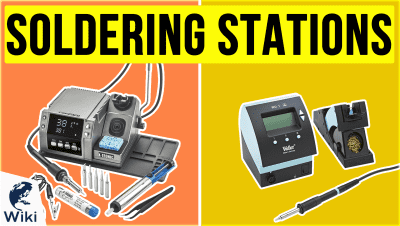The 10 Best Ice Augers

This wiki has been updated 38 times since it was first published in October of 2016. For anglers hardy enough to brave the bitter cold during fishing expeditions, one of these ice augers should be an essential part of your tackle. Our selection includes a combination of manual, electric, and propane-powered models at a range of price points. No matter the type, they all have the sturdy frames and sharp blades necessary to bore through thick layers of frozen H2O with ease. When users buy our independently chosen editorial recommendations, we may earn commissions to help fund the Wiki.
Editor's Notes
February 19, 2020:
This update was pretty comprehensive, replacing more than half our list with up-to-date options.
Eskimo brand augers now take up five entries, a result of their impressive variety of types, sizes, power outputs, and fuel sources. With the exception of battery-powered models, Eskimo is the gold standard when it comes to ice augers.
Their propane-powered Eskimo HC40Q10 — our new top pick — is a perfect example of this. Since Eskimo built its own dedicated propane engine from the ground up (instead of just adapting a gas engine to run on propane), the Eskimo HC40Q10 runs smoother and more efficiently than those competitors. The 1-pound propane canisters that fuel it aren’t as convenient to find as gasoline, but it's still better than dealing with messy fuel mixes and frustrating engine primers. Propane canisters can sometimes be affected by cold weather, but as long as you warm them up in your car or shack first, you should be fine.
Like propane, battery-powered augers are becoming a popular alternative to gas. We made sure to add several of these, including the Strikemaster 40V. Even though it’s now our priciest option, the 5amp battery is powerful enough to justify it.
Regular gas-powered augers are still the most popular type. Their lower price, wide variety, and dependability in extra-cold weather make them a great option for many people. The gas-powered Eskimo Rocket was added as a reliable, powerful option while remaining ultra-lightweight at 22 pounds. If you’re running around a lake chasing down fish, or at a location with only foot-access, a lightweight machine like this will be a lot more comfortable than hauling around a big, bulky monster.
Regardless of which auger you choose, it's extremely important to read the safety instructions before operating. These are powerful machines that can cause significant injury if you’re not careful.
Drilling For Piscatorial Success
Augers with two-stroke engines require the mixing of both gas and oil, so they are less fuel efficient than four-stroke models.
Whether you depend on ice fishing for your livelihood or you consider it a recreational pastime, don't let the extreme seasons get in the way of a big catch. While you need to depend on your boat, instincts, and maybe a fish finder during the warmer months out on the lake, the winter adds sheets of ice as an obstacle to overcome on your path to victory. An ice auger will help you quickly bore into the cold stuff and make a hole large enough to achieve your goals.
An auger is a corkscrew-shaped drilling device designed to bore through a variety of materials that include wood, earth, and ice. The ice auger is particularly useful for ice fishermen who need a quick and effective way to create a hole large enough to insert a line or fish hook into the water below. While the size of the hole you drill depends on the type of fish you're after, most holes are around eight to twelve inches in diameter. Not only is the ability to drill into the ice an important feature, but so is the ability to drill multiple holes in short periods of time without the need for extra manpower or the expense of user fatigue.
The concept of the ice auger is also beneficial for use in scientific research when using ice cores to study things like the climate record. However, a distinction here is that drill barrels used for mechanical or thermal ice coring are typically much larger, given their need to power through multiple layers of glacial ice, compared to consumer-oriented augers that cut through thinner sheets of ice on a lake.
The four types of ice augers available include manual, gas-powered, propane-powered, and electric. Manual ice augers are operated by hand, they are available at low costs, are lightweight, relatively quiet, and generally easy to transport. They also have fewer mechanical parts with the potential to malfunction. On the flip side, they require the greatest amount of physical effort to get the job done. This makes them less useful when drilling multiple holes to find that sweet spot over a body of water, or if the ice is particularly thick and deeper than, say, twelve to eighteen inches.
Gas-powered augers speed up the process of drilling through thick sheets of ice at the expense of being heavier and noisier than their manual counterparts. Gas-powered models come with either two- or four-stroke engines. Augers with two-stroke engines require the mixing of both gas and oil, so they are less fuel efficient than four-stroke models. Four-stroke models also tend to burn cleaner, as they require no such mixing. For that reason. they start up easily, but they are more expensive and are the heaviest of options.
Propane-fueled ice augers are the newest addition to the group. They typically have four-stroke engines, operate quietly, and won't give off any harmful fumes. Electric models offer the same level of power as an auger with a four-stroke engine, but they are somewhat limited by their use of a rechargeable battery.
How To Choose The Perfect Ice Auger
A major decision you must make when investing in an ice auger is whether the use of a manual, electric, or gas-powered model will be best. In order to make this determination, you must first consider when and where you'll use the tool. For example, if you find yourself living up north where the ice tends to be thick, then a gas or propane-powered unit may work best, as you won't be limited by the unit's battery power, nor will you be forced to operate it by hand. You'll also be able to drill multiple holes into the ice without straining yourself. This will definitely come in handy during the winter months and even into early spring when the ice is at its thickest. However, if you're looking for something lightweight to travel with during the warmer months where ice sheets are thinner, a manual auger may do just fine, as well.
A major decision you must make when investing in an ice auger is whether the use of a manual, electric, or gas-powered model will be best.
Will you be fishing in an ice shanty? Weather is an important factor to keep in mind, as people tend to use such shelters to stay warm when waiting for the fish to bite. One must be aware that a gas ice auger could pose additional dangers, considering the fumes it would generate indoors from within an ice shelter. For that reason, a propane or electric option is the better choice in such a circumstance.
Choosing the right blades for the auger is an integral part of the decision. Blades vary in size and length between six, eight, and ten inches. The largest blades are ideal for catching big species, such as Lake Trout. Depending on your needs, ice augers come with anywhere from one to four blades in a combination of standard or serrated styles. Serrated blades chew away at the ice more easily than their standard counterparts. Some auger blades are also pivot-tipped, giving you the advantage of starting a hole faster while gripping the surface of the ice without excess wobbling.
A Brief History Of The Ice Auger
The very first patent for ice-drilling technology was registered by William A. Clark in 1873. Clark's auger was originally designed to bore holes through ice and resembled a large screw with tips for cutting holes of a certain size.
The Minnesota-based StrikeMaster Corporation was the first to introduce their Mora manual hand auger to the United States in 1946. This manual auger featured a circular, corkscrew-shaped blade and greatly improved the efficiency of cutting through ice. Following this invention, the corporation became one of the leading suppliers of a variety of gas and electric-powered models through the 1970s.
Today, propane, gas, and electric-powered augers all dominate the ice fishing industry along with several different brands, including Eskimo, Jiffy, and StrikeMaster with varying weights and engine sizes.


